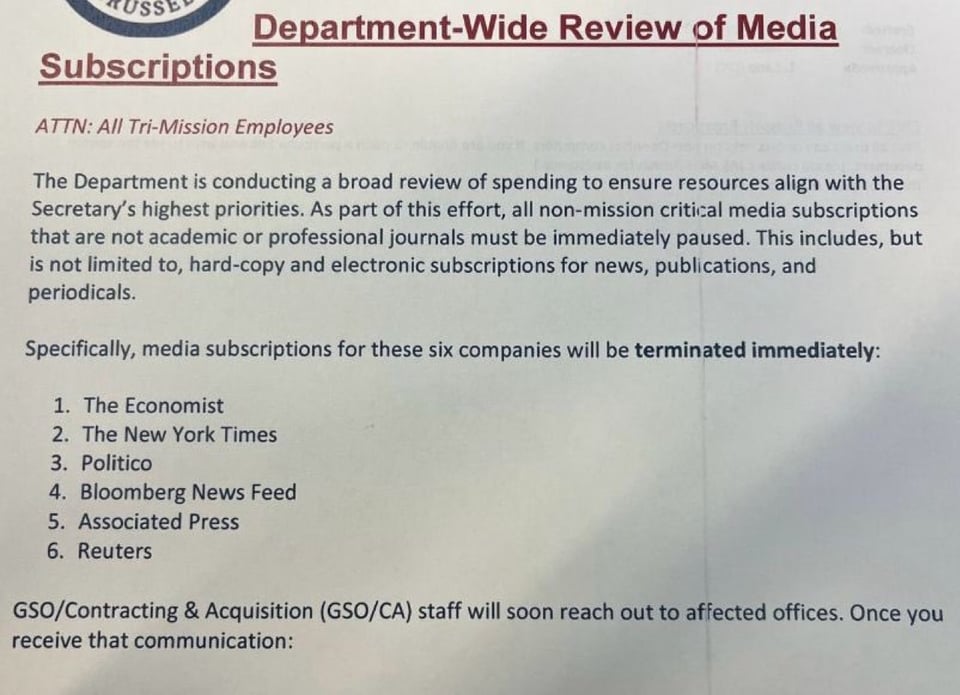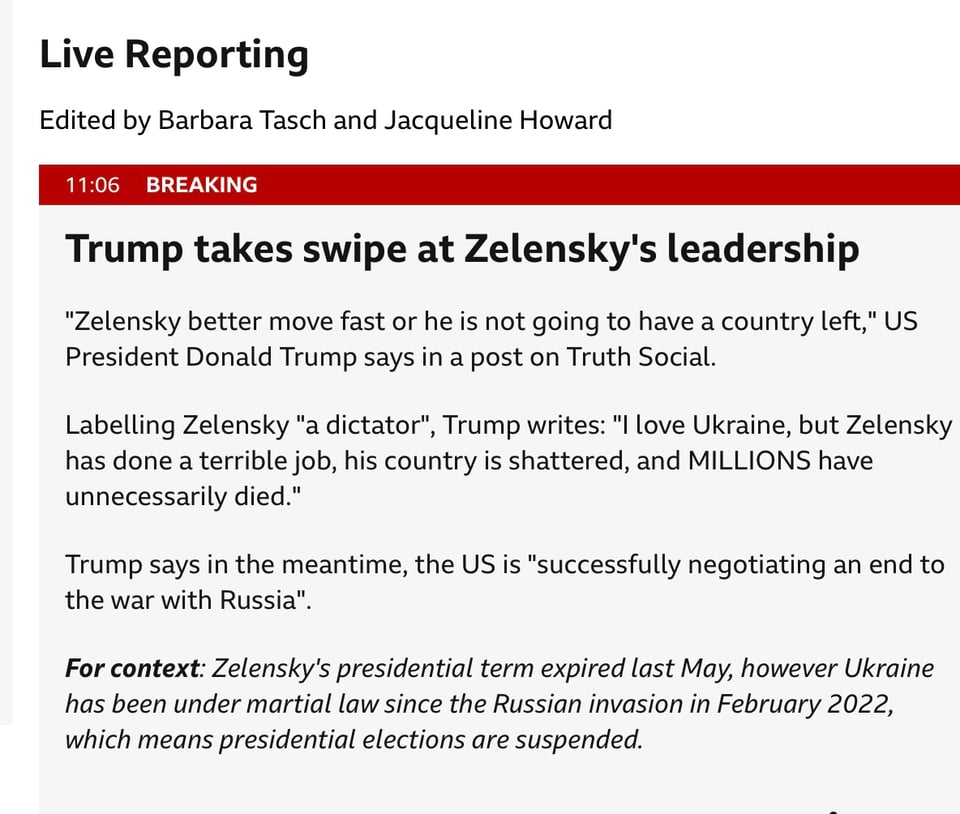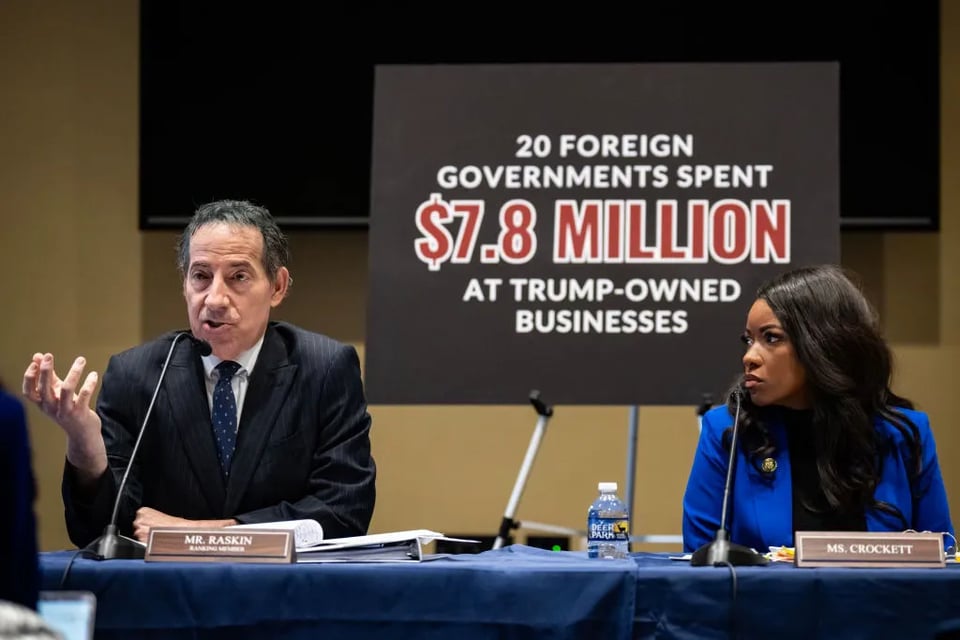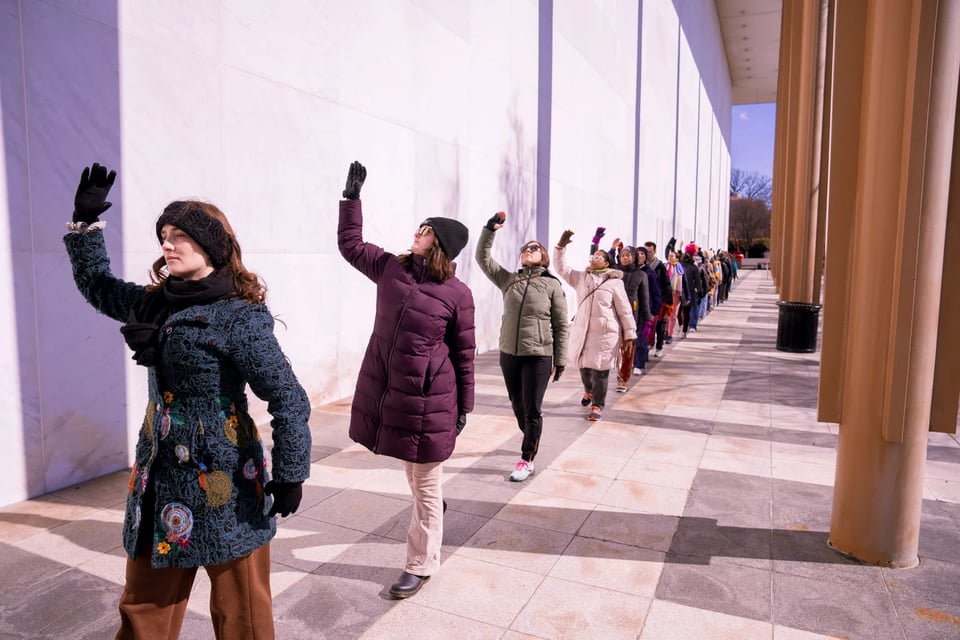Thursday, February 20, 2025. Annette’s Roundup for Democracy.
Worst Trump Action of the Day.
It will likely always be hard to pick.
I pick mine. You pick yours.
Maybe by circulating the WTA, we can figure out how to counter it.
In the case of today’s WTA, maybe a call to the State Department? Or your two senators? Certainly it is worth a post on social media.

State Dept. orders cancellation of news subscriptions around the world

The State Department has ordered the cancellation of all news subscriptions deemed “non-mission critical,” according to internal email guidance viewed by The Washington Post.
The move aligns with the Trump administration’s crackdown on media companies that count the U.S. government as paying customers.
A Feb. 11 memo sent to embassies and consulates in Europe described the mandate as part of an effort to reduce spending.
The email read, in part, “Considering this priority, posts are asked to immediately place Stop Work Orders on all non-mission critical contracts/purchase orders for media subscriptions (publications, periodicals, and newspaper subscriptions) that are not academic or professional journals.”
The mandate applies globally, to hundreds of U.S. embassies and consulates, according to a State Department official who spoke with The Post on Tuesday on the condition of anonymity to discuss internal matters. Embassy security teams rely on news coverage to prepare for diplomatic travel in conflict zones.
Cancellation of subscriptions — including to local news outlets — could hinder their assessment of threats, the official said.
A State Department spokeswoman did not respond to a request for comment. A Feb. 14 memo directed procurement teams at embassies and consulates to prioritize the termination of contracts with six news organizations in particular: the Economist, the New York Times, Politico, Bloomberg News, the Associated Press and Reuters. State Department personnel were told that they could submit a request to maintain a news subscription but that it “must be done within 1 sentence.”
The guidance laid out possible justifications — if the subscription affects the safety of U.S. personnel or facilities, or if it is required by treaty or law, or if it yields an affirmative answer to one of the following questions: “Does it make America safer? Does it make America stronger? Does it make America more prosperous?”
A State Department employee who received the memos, and shared them with The Post, expressed concern that terminating news subscriptions — particularly to local outlets — would deprive embassies and consulates of information necessary to complete their mission.
“This will endanger American lives overseas because we are being cut off from news sources that are needed on a daily basis,” said the employee, who spoke on the condition of anonymity because they are not authorized to comment to the press.
On a teleconference the day after the initial memo was sent, employees were given a presentation about the mandate, with one slide saying it was enacted “in support of the administration.”
About a week before the Feb. 11 guidance went out, White House press secretary Karoline Leavitt said the government was canceling subscription contracts with Politico, which had become a target of criticism among allies of the president, including Elon Musk, after users on X called attention to government contracts for Politico Pro subscriptions. Other wings of the government, including the Agriculture Department, also said they planned to cancel subscriptions to Politico.
Employees at the General Services Administration were told to “cancel every single media contract,” according to Axios.
And the Trump administration has attacked the Associated Press — one of the six news outlets tagged for immediate cancellation in the Feb. 14 State Department memo — over the wire service’s decision to continue using the term Gulf of Mexico instead of Trump’s Gulf of America.
Associated Press reporters have been banned from attending White House events since Feb. 12 and were told that they would not be able to travel on Air Force One. (John Hudson, Washington Post).
One more thing.
Trump did this yesterday too.👇


So it was hard to decide what was the Worst Trump Action, but in the end, I struck with the act that was
an attack on the press
an action to stifle free speech
an action to end debate worldwide.
Trump ended media subscriptions for State Department Personnel.
This is good. Will the dam break?
Two GOP senators rail against Putin despite Trump’s rosy assessment of Russian leader
Two prominent GOP senators, Sen. Roger Wicker of Mississippi and Sen. John Kennedy of Louisiana, criticized Russian President Vladimir Putin amid negotiations in the peace deal to end the war in Ukraine.
Senator Wicker (MS)
Senator Kennedy (LA)
Where can we find leadership for Democracy?
Do we need leaders? Or is leadership what we need?
Or do we simply need to recognize the leadership or leaders we have?
A College President speaks out.
Say Something.
What colleges will do under Trump: How presidents of universities can react.
For heads of institutions, it’s all too tempting to do what’s easy.
BY MICHAEL S. ROTH, President of Wesleyan University.

In 2024 Dictionary.com chose “demure” as the word of the year. On college campuses (or at least in their presidents’ offices and board meeting rooms) the word of the year, in the wake of the war in Gaza and the campus protests that followed, was “neutrality,” which has a similar vibe. One might think that those who embrace neutrality do so either because they have no strong views, or because they do and are afraid to express them.
Some university leaders, following the University of Chicago, have tied themselves to the more agreeable notion that were they to weigh in on issues, this would chill speech on campus—that others will be encouraged to speak up if they keep their own mouths shut. The august American Council of Trustees and Alumni has urged all trustees to preserve “the high purpose of our academic institutions” by ensuring that their institutions stay out of political disputes—silence is golden, especially when the heat is on. Some creative leaders have demurred even about making a commitment to neutrality, and, like Nicole Kidman’s character in Babygirl, have discovered the pleasures of restraint. Institutional restraint.
In the past months, since Trump’s victory in the general election, leaders in the worlds of business and education have been rushing to show that they no longer have any political beliefs. Facts? Why check them? Privilege? Who’s to say that the megarich don’t deserve their advantages? Anticipating how best to be obedient, they aim to please those at the vanguard of what Mark Zuckerberg called a “cultural tipping point.”
It’s one thing to be reminded that “elections have consequences,” but quite another to insist that the best response to the abuse of authority is to be restrained, demure, neutral. For university leaders the exception is their opposition to endowment taxes. On this topic, they’re inclined to be positively brat.
It may seem that asking corporations, universities, and other organizations to “keep their mouths shut” is a conservative position. Far from it. Since the 18th century, thinkers associated with conservatism and classical liberalism have emphasized the importance of having an independent civil society, the informal networks in a country that are adjacent to the political sphere. Businesses and schools, libraries and neighborhood associations, are crucial elements of that sector. From Baron de Montesquieu and Edmund Burke in the 18th century to Alexis de Tocqueville and John Stuart Mill in the 19th, political philosophers have underscored that freedom depends on the pillars of civil society not being subsumed by those with governmental authority.
Tocqueville wrote that “Local institutions are to liberty what primary schools are to science; they put it within the people’s reach. … Without local institutions a nation may give itself a free government, but it has not got the spirit of liberty.” And Mill underscored the “need for political devolution and the diffusion of power and initiative within the great entrenched institutions of our society.”
Authoritarians, by contrast, have long known that total control will elude them if they don’t eradicate the autonomous support engendered within civil society by cultural, religious, commercial, and educational institutions. That’s why the Nazi party announced the policy of Gleichschaltung, the coordination of all aspects of German society in line with the ideological goals of the party and its leader. Under Mao, the Cultural Revolution was meant to ensure something similar. All aspects of society—from family relations to schools, from farming to music—would be cleansed of independent allegiances and aligned with the party and its leader. Authoritarians love to talk about their devotion to the Truth. But it’s only the truth as they’d like it to be. The official newspaper of the Soviet communists was, after all, entitled Pravda—“Truth.”
Leaders in civil society shouldn’t be “demure” in the face of authoritarian attempts to align all power with a president’s agenda, civil society be damned. Business and civic officials, religious authorities and college presidents should weigh in when they see the missions of their institutions—not to speak of the health of their country—compromised. This wouldn’t be a novelty.
Clergy have often done this, as have other local officials. Although university leaders do have a long history of capitulating to the powerful, there have been times when they have stood up for the values on which the missions of their institutions were built. Frances Wayland at Brown University spoke powerfully against slavery, as did Jonathan Blanchard, the president of Knox and then Wheaton College. Charles Finney at Oberlin College and Horace Mann at Antioch also were prominent in their support of abolitionist activities. A century later, Kingman Brewster at Yale, Theodore Hesburgh at Notre Dame and Harold Taylor at Sarah Lawrence made sure that critics of the Vietnam War got a hearing. And they were not demure about speaking out themselves.
New administrations in Washington naturally try to bring together forces that will allow them to make progress on their agendas. But in the past, they have done this while recognizing the importance of working with others with different points of view. A healthy democracy depends on a dynamic mixture of competing opinions. University leaders themselves should do more to ensure this dynamic mixture on their own campuses. Too many of us have led colleges that have become politically homogeneous. This leaves us out of touch with many other Americans, and it means we learn less because too often we hear the same views echoing each other.
Now we face a Trumpian administration intent on demonizing any opposition—either labeling differing views as “crazy,” or attaching labels to them, like “Marxist,” “ideologically corrupt,” or “transgenderist.” This is a classic authoritarian move: create scapegoats and undermine the health of civil society in order to increase the power of the leader and his loyalists.
Corporate and educational leaders must not put on a demure face and stay silent while civil society is undermined by the diktat of executive orders. We must not sacrifice academic freedom and a healthy civil society for the short-term gains of anticipatory compliance. We must instead cultivate in our institutions the ability to bring different kinds of people together in common purpose, the will to protect the vulnerable, and the resilience needed for our institutions to successfully pursue their missions. Their missions, not the agenda of whoever controls the powers of the central government. Let’s hope that the 2025 word of the year isn’t “submissive.” (Slate).
__
They’re Fighting For Us.


Check out these recent New York Times headlines about the state of the Democratic Party:
Many Americans Say the Democratic Party Does Not Share Their Priorities
‘The Damage to the Party Is Profound’: Three Opinion Writers on What Happened to the Democrats
Trump Leaves Democrats Dazed and on the Defensive
‘We Have No Coherent Message’: Democrats Struggle to Oppose Trump
Powerless, Democrats Debate Just How Deep in the Wilderness They Are
Democratic Party is a Rotting Corpse Unworthy of a Decent Burial
Okay, I made that last one up. But it’s only a matter of time before the Times prints it.
Here’s a headline I’d propose:
Democrats Across the US are Fighting Back
That one might not be clickbait, but it has the benefit of being true.
The corporate media’s “coverage” of the Democrats has chosen to overlook the party’s most spectacular asset: a roster packed with gifted politicians. In fact, I’d argue that the Democrats have more talent than they’ve had in a generation.
And they’re fighting for us.
On the most recent episode of my podcast, I asked TBR readers to name the Democrats they’d like to see lead the fight against the fascistic Muskocracy. I was overwhelmed by the sheer number and enthusiasm of their responses. Here are a few of them:
It should be a coalition of people who bring skill and passion to the table. I would see AOC, Katie Porter, Adam Kinzinger, Jamie Raskin, Liz Warren, Beto O’Rourke, Pete Buttigieg, among them. –Sandy
Add Jasmine Crockett to the list. –Curtis
JB Pritzker from Illinois. He is the best Governor we've had in a very long time. –Julie
Definitely Whitmer and Shapiro. –Trudy
How about Wes Moore? And Gretchen Whitmer. Lots of good talent with brains out there. I would also add Maxwell Frost from Florida. –Jane
Jamie Raskin would be a good pick. –Jim
My vote for the Democrat to lead the resistance is either AOC or Jasmine Crockett. Both of whom are easily able to overwhelm either Trump or Musk. –Susan
Letitia James who is fearless. –Mary
Senator: Raphael Warnock. House: Sarah McBride (Del); Becca Balint (Vt). If you haven’t heard of them, find them. Brilliant minds and kick-ass attitude. Governor: Gretchen Whitmer. –Alan
David Hogg. He lived through the hell of a Florida high school massacre as a student, and hasn't stopped since. –Robert
CT Sen. Chris Murphy –Gail
Jamie Raskin, Pete Buttigieg, Sheldon Whitehouse. –Kathy
Katie Porter and Stacy Abrams. Powerhouses. –Robert
I love Jamie Raskin. Also Amy Klobuchar, Elizabeth Warren, Hakeem Jeffries, Katie Porter. –Debbie
Jamie Raskin, who said, "Given that I was marching at age three, you know I’m not letting any coup-plotting, election-denying, insurrection-supplying autocrat, kleptocrat, plutocrat or theocrat, or any techno-feudalist Silicon Valley broligarch aspiring dictator, turn me around now. I am going to honor and participate every day in this urgent national fight for strong constitutional democracy, personal freedom and social progress." –Lyn
Just reading this list of suggestions gives me heart. Yes. We can get through this! –Nancy
Yes, we can get through this. And we will.
I started this post with a collection of super-annoying headlines, so I’d like to end with a more enjoyable one:
Tesla Sales Are Tanking Across The World
This headline isn’t from the New York Times. I found it on a website dedicated to news about electric vehicles. Have a nice day! :)
From me.
Please notice - all the Democrats suggested above 👆 are already speaking out and undoubtedly will continue to speak out.
The people we don’t hear from, that have a responsibility to speak, are the former President Joe Biden, Vice President Kamala Harris, former Presidents Clinton and Obama, and even Secretary of State Clinton, Former Speaker emerita Nancy Pelosi, and former Congresswoman Liz Cheney who finally tweeted last night.

These have been our leaders. A defeat in one election should not stop them from speaking. An occasional tweet is not enough.
I ask a different question too.
How about You as a leader for Democracy! Or as a Rabbi I know said, “There is no Messiah! You’re it.”
As leader, feel free to share this headline 👇 we don’t see in our press.
Republicans, still quaking in their boots, still silent about Trump’s authoritarianism.
Start your leadership by posting this headline 👆 on your social media sites.
The Arts can give us truth.
The liar Trump grabbed the Kennedy Center to stop truth from the arts and artists. As the Times said on Tuesday, “What will a thin-skinned showman do with an institution central to Washington’s cultural life?” Expect the worse.
Performers protest Trump leadership at Kennedy Center with dance
Performers dance outside of the Kennedy Center in Washington, D.C., on Monday. The dance was part of a protest against new leadership by President Trump.

Protesters chanted across Washington, D.C. on Monday to demonstrate against executive orders signed by President Donald Trump. But outside the John F. Kennedy Center for the Performing Arts, one of the performing arts landmarks of the United States, there was a different kind of protest: a dance.
Thirty-four dancers performed The Nelken Line, a piece by choreographer Pina Bausch that pays homage to the seasons. It's been performed widely since Bausch created it in 1982. There's even a tutorial.
In the piece, dancers walk in a single-file line and make synchronized movements.
"It felt symbolic in that we're moving in unison," says dancer and educator Kelly King who organized the protest, "And there's something just compelling to see a straight line of movers dancing this way in a march."

Dancers of the DMV came together today in peaceful protest at the @kennedycenter Thanks to @keirahartmendoza for your partnership and to all who participated 💗 Video by David Dowling 🙏
Dancers of the DMV came together today in peaceful protest at the @kennedycenter Thanks to keirahartmendoza for your partnership and to all who participated 💗 Video by David Dowling 🙏
The dancers are protesting the leadership changes at the Kennedy Center, which operates under a private-public partnership and receives some federal funding. Traditionally, it has a bipartisan board. But now the board consists of members appointed solely by Trump, with the president himself as the chair, which is the first time a president has served in that role.
Deborah Rutter, former president of the Kennedy Center, gives her first interview since the center's board voted to fire her and install President Trump as its new chair.
King says, historically, the Kennedy Center's dance offerings have been largely focused on "classical ballet and very white programming or European-based programming." But in the past decade or so, she's seen a shift that includes "many more contemporary works and some under the radar dance offerings that give both artists and audience an opportunity to expand their horizons. And that has been really exciting and encouraging to see."
She and the other dancers are worried about whether that kind of diversity will continue under the new administration.
A spokesperson for the Kennedy Center tells NPR, "There have not been changes made to the Center's dance programming nor are there any changes planned."
King says the protest came together quickly. After spreading the word on social media, she set up two Zoom rehearsals. She chose the Bausch work because it's simple enough that dancers of all ages and abilities could master it easily.

Performers gather outside of the Kennedy Center on Monday to protest new leadership. They're worried that the diversity of dance programming might be curtailed.
King says nobody at the Kennedy Center tried to stop any of the dancers, though a handful of security guards followed them as they danced around the perimeter of the building for about 30 minutes.
"They were unsure of what they were going to encounter with us," says King, "And as I spoke to them individually and they saw what we were doing, they realized that we were certainly not a threat. And I think perhaps by the end they were entertained." (NPR)
In the aftermath of the overturning of Roe and in the light of the misogyny of Trump and his cult, Truth is being presented on the stage in London.
An Abortion Scene Gets Theater Audiences Talking, and Fainting.

Harmony Rose-Bremner in “The Years” at the Harold Pinter Theater in London.
“The Years,” running in London, dramatizes a woman’s life from teenage thrills to later-life sex. One intense scene is causing audience members to pass out.
About 40 minutes into a recent performance of “The Years” in London, Stephanie Schwartz suddenly felt ill and had to put her head between her legs.
Onstage at the Harold Pinter Theater, the actress Romola Garai was portraying a young Frenchwoman trying to give herself an abortion with a knitting needle. The scene was set in 1964, a time when medical abortions were illegal in France, and Garai’s character wasn’t ready for motherhood.
Schwartz, 39, said she had started feeling faint as Garai’s character, Annie, described her attempt to carry out the procedure in stark, if brief, detail. But then, Schwartz recalled, there was a commotion in the balcony above. An audience member had actually passed out.
Since opening last summer for a short run at the Almeida Theater, then again last month on the West End, “The Years” has been the talk of London’s theaterland. That has as much to do with audience reactions to the six-minute abortion scene as the near-universal critical acclaim that the production and its five actresses received for their powerful portrayal of one woman’s life.
While fainting theatergoers are nothing new — several passed out over the onstage torture in Sarah Kane’s “Cleansed” at the National Theater almost a decade ago — the sheer number keeling over at “The Years” stands out. Sonia Friedman, the show’s producer, said that at least one person has fainted at every performance despite a warning to ticketholders.

Romola Garai assumed that British theatergoers were so accustomed to viewing bloody productions of Shakespeare that they were unlikely to have a strong reaction to the play’s abortion scene.
Friedman said that she realized the scene’s power, especially at a time when many women, particularly in the United States, fear a rollback of reproductive rights. After failing to carry out the home abortion, Annie describes her visit to a backstreet clinic, then, later, miscarrying the fetus at home. Still, Friedman said she worried that the scene had overtaken discussion about a play that portrayed women’s lives in all their “power, pain and joy.”
“What should dominate the discussion,” Friedman said, “is, ‘Why has it taken this long for such a work about women, by women, to be onstage?’”
Based on a 2008 autobiographical book of the same title by Annie Ernaux, the 2022 recipient of the Nobel Prize in Literature, “The Years” is an attempt to not just capture a woman’s life, but also show France’s shift toward sexual liberation and consumerism.
Eline Arbo, the play’s director, said that, when she read the book, she immediately wanted to bring its blend of emotional, political and social history to the stage, even if Ernaux’s writing contained no dialogue. “Everybody thought I was crazy,” Arbo said.
She didn’t think twice about including the abortion scene. It was such a key moment in Ernaux’s life, Arbo said (Ernaux almost bled to death), adding that it was vital to remind audiences of the importance of legal abortion.
Garai said she performed the abortion scene when she auditioned for the show, and had felt it was a “great, accurate depiction” of something that many women experienced when abortion was illegal. “It’s their bodies, their histories,” Garai said.
During rehearsals, Garai recalled Arbo mentioning that a handful of audience members had fainted when the director staged the show in the Netherlands. But Garai said she had dismissed the possibility of similar reactions in London. British theatergoers, Garai recalled thinking, were used to sitting through bloody productions of Shakespeare.
Yet, two days after the play opened at the Almeida Theater, the stage manager rushed onstage mid-performance and stopped the show. Someone had fainted.

From left, Anjli Mohindra, Deborah Findlay, Gina McKee, Garai and Rose-Bremner all play the same character at different points in her life.
The cast feared they had traumatized a woman who had experienced an abortion, but it soon became clear there was no pattern: Men were fainting, as well as women.
Perhaps the summer heat was a contributing factor? But now that the play was running on the West End, during a bitterly cold winter, the fainting was “even worse,” Garai said. (The run concludes April 19.)
Arbo said that her best theory for the reactions was that the show’s stripped-back style left room for audiences to imagine the abortion themselves, and so increased the scene’s intensity. Really, though, she said, she had no idea why West End audiences were fainting. “Do you have an answer?” she asked. “I don’t!”
During a recent performance, the show, meant to run almost two hours without intermission, was stopped twice for about five minutes so that ushers could attend to flustered theatergoers. Other audience members said they had mixed feelings about those interruptions. Mary Tyler, 65, a retired management consultant, sighed when the play was first halted. “You are joking,” she said. “That is so rude to the performers.”
When the play stopped a second time, Chi Ufodiama, 35, a public relations worker, said she was sympathetic if someone who had experienced abortion was struggling, but she was “suspicious” that the pauses were a deliberate part of the show. (Garai dismissed that notion: “Why would we do that?”)
During each pause, Garai walked to the back of the stage and formed a circle with the other four woman playing Annie at different points in her life: Anjli Mohindra, Harmony Rose-Bremner, Gina McKee and Deborah Findlay. Garai said the cast had decided to remain onstage partly to signal to the audience that the play was about women’s communal experience. “We’re all here to tell the rest of this story together,” she said.
Once ushers had ensured the audience member was all right (they sometimes provide bottles of water or medical assistance), Garai returned to the front of the stage and continued acting as intensely as before, without missing a word. It was no different than having a director interrupting her mid-rehearsal, Garai said.
Within minutes of enduring the abortion, her character had moved on from that moment: She gets married, becomes a mother, and soon the play was racing through a divorce and other scenes that shed light on women’s lives. Some were comedic, like a moment when McKee, playing Annie in middle age, attends her first aerobics class. Other scenes were more passionate, including one in which Findlay, portraying Annie in her 50s and 60s, describes an affair with a younger man.
For Garai, that May-December romance was as strong a statement as the abortion. Garai said it showed that older women “not only can desire, but can be objects of desire,” adding she had never seen such a relationship on a London stage before.
Even for Schwartz, the audience member who felt she came close to fainting, the play’s broader messages struck home. She said certain moments made her ponder what past generations of women lived through, as well as reflect on her own life experiences and those of her friends.
The play was “such a relatable depiction of womanhood,” Schwartz added, and that meant it had to include the abortion scene, too.